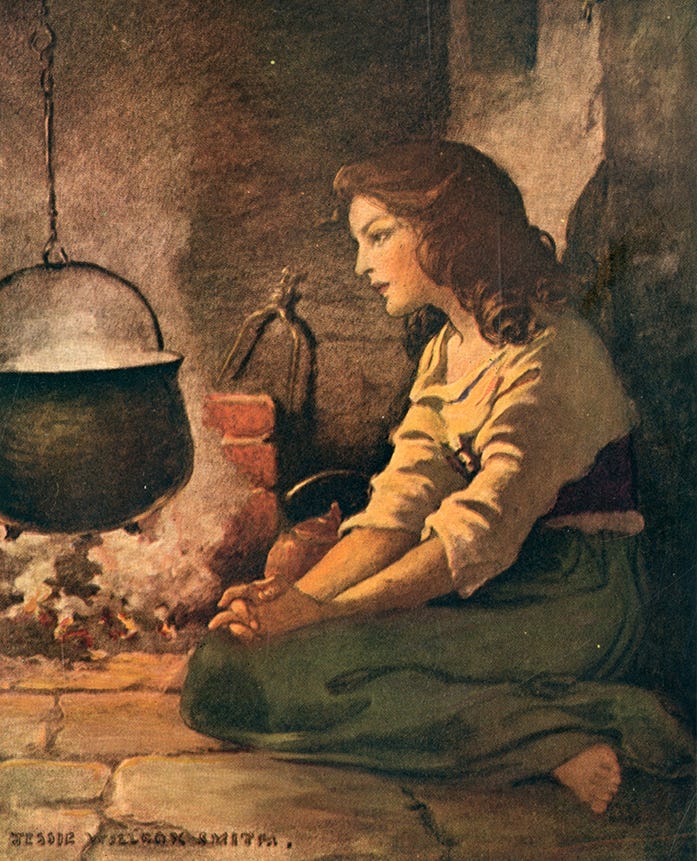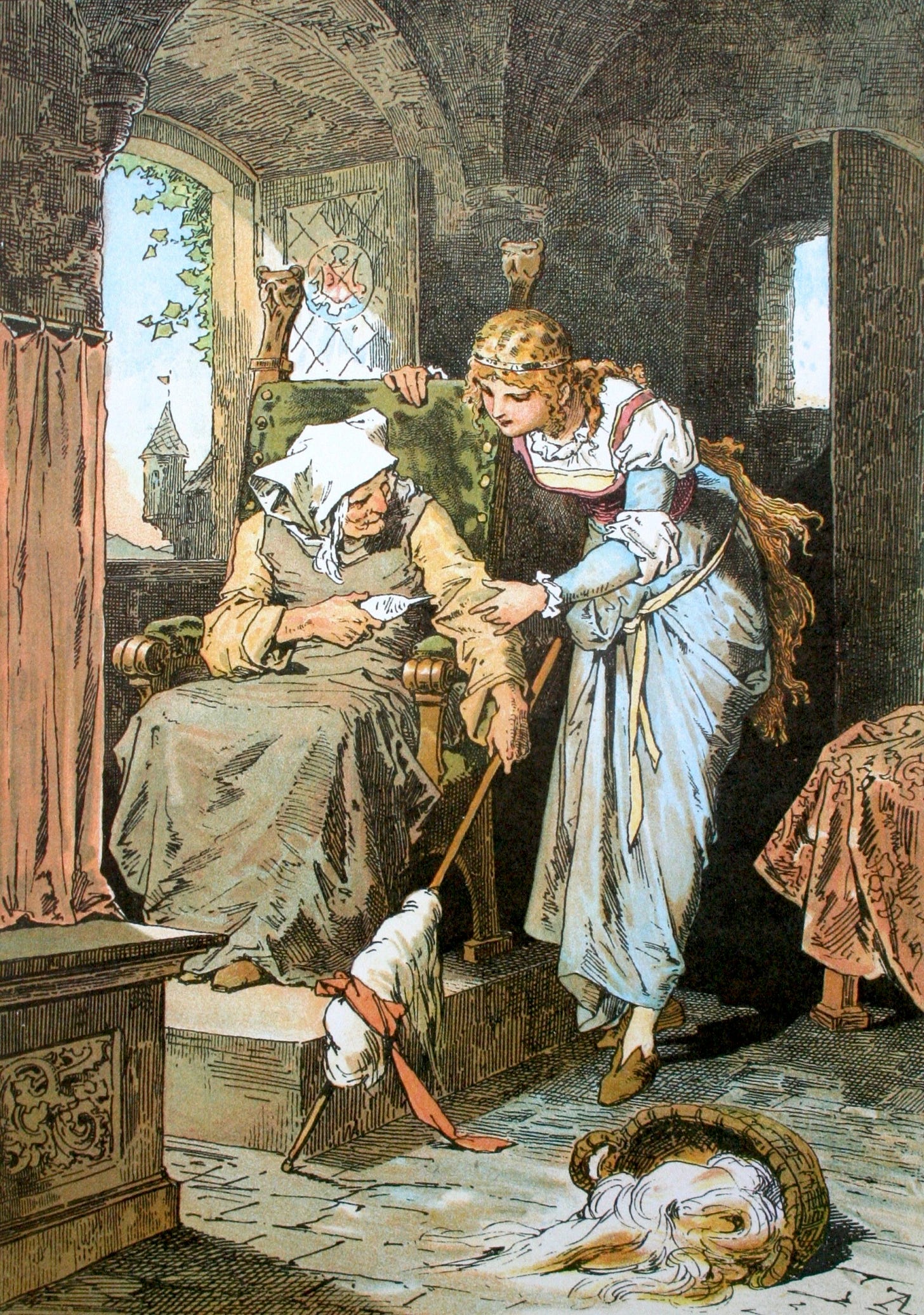The Fairy Tale Heroine: Live and Create Her Journey
Chapter Two: Loving Mother, Part I
These times call for the feminine heroic! With this chapter, we begin her journey, step-by-step, from the very start, with interactive prompts to follow along. I look forward to reading your stories and comments each week.
And so, we begin! The Fairy Tale Heroine’s journey typically starts with the death of her loving mother. It is her first, essential challenge in the ancient feminine tales. Though it may seem cruel to begin a story with the death of one’s parents, it allows the protagonist the individual stance of the heroic. Indeed, the same is often true in the hero’s journey archetype: the young man is orphaned or separated from his parents and home.
But in the feminine quest, the rupture from her birth mother is explicit and complete. The symbiosis between mother and daughter that could smother self-awareness in the daughter is severed first in almost every tale.
In “Aschenputtel” (Little Ash Girl) from Grimms' Fairy Tales (1812), a variant of the “Cinderella” tale type, the story starts with a fateful dialogue between mother and daughter:
“The wife of a rich man fell sick, and as she felt that her end was drawing near, she called her only daughter to her bedside and said, "Dear child, be good and pious, and then the good God will always protect you, and I will look down on you from heaven and be near you."
“Thereupon she closed her eyes and departed. Every day the maiden went out to her mother's grave, and wept, and she remained pious and good. When winter came the snow spread a white sheet over the grave, and by the time the spring sun had drawn it off again, the man had taken another wife.”
###
In this beginning excerpt, we sense the hovering, loving mother even in death and her exhortations to be “pious and good,” as well as the constant devotion of the grieving daughter. The potential for enmeshment between a loving mother and her daughter can continue after death and prevent the daughter from exploring her unique path and the realization of her individual potential.
Hence, enters the stepmother whose role in this fairy tale along with other “wicked” characters in the heroine’s journey tales advances the heroine’s path with the force of destiny.
In "La Belle au Bois Dormant" (Sleeping Beauty in the Wood) from Charles Perrault’s Tales of Mother Goose (1697), the long awaited birth of a princess is marked with a grand christening and gathering of all the fairies in the realm as godmothers to the baby, each to bestow a gift:
But just as all the fairies were sitting down to table an aged fairy was seen to enter, whom no one had thought to invite—the reason being that for more than fifty years she had never quitted the tower in which she lived, and people had supposed her to be dead or bewitched.
By the king's orders a place was laid for her, but it was impossible to give her a golden casket like the others, for only seven had been made for the seven fairies.
The old creature believed that she was intentionally slighted, and muttered threats between her teeth.
Presently the fairies began to bestow their gifts upon the princess. The youngest ordained that she should be the most beautiful person in the world; the next, that she should have the temper of an angel; the third, that she should do everything with wonderful grace; the fourth, that she should dance to perfection; the fifth, that she should sing like a nightingale; and the sixth, that she should play every kind of music with the utmost skill.
It was now the turn of the aged fairy. Shaking her head, in token of spite rather than of infirmity, she declared that the princess should prick her hand with a spindle, and die of it. A shudder ran through the company at this terrible gift. All eyes were filled with tears.
But at this moment the seventh fairy stepped forth. "Take comfort, your Majesties," she cried in a loud voice. "Your daughter shall not die. My power, it is true, is not enough to undo all that my aged kinswoman has decreed. The princess will indeed prick her hand with a spindle. But instead of dying she shall merely fall into a profound slumber that will last a hundred years.
###
There could be no greater contrast between the perfection of the “pious and good” gifts bestowed upon the princess and the curse of death given by the aged “wicked” fairy out of spite. But the incredible virtuousness of the first six gifts are too good to be true for a simple human, princess or not.
In fear of the curse, all in the castle sought to protect, shelter, and infantilize the innocent girl. The king issued an edict forbidding all persons, under pain of death, to use a spinning wheel or keep a spindle in the house. The princess is kept in a bubble, an illusion of safety, in the life of youthful maid, undiscerning and perfect.
The princess has become what her mother wanted, within her control and her castle, safe from other influences or danger. The princess’s delayed development, a sweet girl, a mommy’s girl, mute, passive, connects her forever to her beloved mother and the seven good fairies’ gifts.
She is kept from the curse of pricking her finger on the spindle, drawing blood, often a symbol of the onset of puberty and menstruation.
But as fate would have it:
At the end of fifteen or sixteen years the king and queen happened one day to be away, on pleasure bent. The princess was running about the castle, and going upstairs from room to room she came at length to a garret at the top of a tower, where an old serving woman sat alone with her distaff, spinning
The princess wanted to learn how to spin. Partly because she was too hasty, partly because she was a little heedless, but also because the fairy decree had ordained it, no sooner had she seized the spindle than she pricked her hand and fell down in a swoon.
###
When the princess pricks her finger and falls into a deep sleep, she is in a stasis, coma, with rose briars growing up along the outside walls over time—sleeping in a gilded fantasy of girlhood, forever young and chaste. She sleeps in golden splendor for one hundred years, but does not age.
In the recent movie, Barbie (2023), is in a perpetual sleep in Barbie Land, repeating each day, mirroring her identity in every other women without delineation from one another. In a time warp of perfection, the doll, Barbie, is disturbed by a human mother’s fear of dying to her daughter. In breaking out of her bubble, waking up to another dimension, Barbie chooses to mature.
In Poor Things (2023), Bella, separated from her suicidal mother by inhabiting her mother’s dead body, struggles to grow beyond her within her. The archetypal symbiotic relationship is literal in this film and underscores how profoundly women can internalize their own mother’s pain and woundedness. As Bella explores her capacities, sexuality, intellect, she gradually awakens her toddler brain.
Pollyanna, a 1913 novel by American author Eleanor H. Porter, is considered a classic of children's literature. Pollyanna Whittier, an eleven-year-old orphan goes to live in the fictional town of Beldingsville, Vermont, with her wealthy but stern and cold spinster, Aunt Polly Harrington. Pollyanna's philosophy of life centers on finding something to be glad about in every situation, no matter how bleak it may be. Pollyanna has been adapted for film several times. Some of the best known are the 1920 version starring Mary Pickford, and Disney's 1960 version starring child actress Hayley Mills, who won an Oscar for the role.
Many criticize the “Pollyanna” stereotyped girl-woman as delusional, in a fantasy world, an excessively, blindly optimistic young woman who never matures.
Even modern women can remain in a sleep, undeveloped, sheltered, and not risk separation from the “too good” mother’s protection or expectations. They want to do things the way “Mom did”; cook and bake with her recipes, find vintage cookware in thrift shops to replicate her kitchenware. They quote homespun sayings of maternal lore.
Marie-Louise Von Franz wrote in The Feminine in Fairy Tales that, “Women, even more than men, tend to identify with their own sex, and to remain in this archaic identity [of mother-daughter] ... This participation mystique has a great impact on women.” They cannot separate or dis-identify from others within their group.
They can become doll-like in appearance and obsess dressing in a predictable style as a perennial girl, such as the 1960s iconic supermodel, Twiggy, with her innocent doe-like eyes and undeveloped, skinny body. In the recent movie, Wicked, Part I (2024), the character, Glinda, is a child-woman played by Arianna Grande, wrapped up in gauzy pink without wit or competence.
So, the feminine quest first requires separation from the “too-good” mother who would tie her daughter to her apron strings and disallow her own identity to mature. On the other hand, some women revert to a non-threatening, malleable girl woman on their own, playing “dress up” for their entire lives.
My Sleeping Beauty Story
Possibly, we all have times when we go to “sleep” as women, regress to a guileless girl, oozing naïve charm with the allure of the wide-eyed, sweet, attractive adolescent.
When I worked in a large, corporate law firm in San Francisco as an assistant librarian in the mid-1970s, I found myself in an exclusively male workplace—ivy league attorneys on three top floors of a new high rise. The only women were secretaries, dressed to the nines every day. The house manager was gay—he arranged floral displays, catered meetings and the staff lounge.
The house manager nicknamed me the “Sweetheart of Sigma Chi,” with a cynical grimace because in that environment I became hyper-cute, flirted and teased all the attorneys. The attorneys called me “That Girl” after the popular TV sitcom with Marlo Thomas whose character was a bright-eyed, wholesome, aspiring actress with “darling” clothes and a dazzling smile, one of the first TV roles for an unmarried young woman not living with her parents.
Each morning, I woke up hours early to have a protein shake, style my long hair enhanced with auburn highlights, and apply make up in sculpted layers with three shades of eye shadow. It was fun, possibly entertaining, but ultimately unfulfilling. After eighteen months, I resigned my job from the Land of Pinstripes to pursue my own, authentic goals.
Lately I’ve learned the term, “that girl,” is a thing, a life style, currently trending, critiqued in an article by Emily McGowan (2022):
“The whole concept is steeped in toxic positivity, but it’s also an escape that so many of us need right now. That girl isn’t interrupted by a grumpy child, a messy partner, or a stack of bills higher than her organic peanut butter toast.”
Eventually life gets in the way; we emerge messier when we meet daunting challenges imperfectly. We grow up and learn our own way. We separate from mother and the non-delineated, group think of other women. We wake up to ourselves.
###Chapter Two, to be continued...
PROMPTS
Follow along the heroine’s stages together with a notebook—digital or written—or a portfolio for illustrations, photographs, a collage, poster, story board, road map, or a game. The creative possibilities are endless as we explore the fairy tale heroine’s epic journey in our own way and for our time.
When in your adult life did you go to “sleep” as a child-like, doll-like woman, in the objectified state of passive pleaser, like your mother, or a “too good” woman?
Describe the time period in some detail: setting, people, your image and behavior, the pitfalls and resolution.
What is your experience of women who are “asleep,” undeveloped as separate individuals, who present themselves as an attractive, agreeable ingénue?







Wow, what a great delve into the Sleeping Beauty tale! And I love that picture of you! I resonate with the sleeping beauty story so much. My mother gave me a wonderful, stable childhood and taught me to always be sweet. I always since "sought the spindle" to be initiated into the darkness and blood of life. I might get a tattoo with those briar thorns reaching up my arm....
Kate, so much rich thought-material packed away here. Thank you! I'll be back for reread as soon as I can manage it. Just want to say quickly that I'm struck by That Girl, especially this, from McGowan: "it’s also an escape that so many of us need right now."
As our world seems to darken, I'm hearing from so many women who are searching for an escape, whether it's That Girl or The Girl Who Hides Under Her Bed. But we need to remind ourselves that to be real means facing our reality as fully as we can. And even though it means pricking our fingers, all 10 of them.